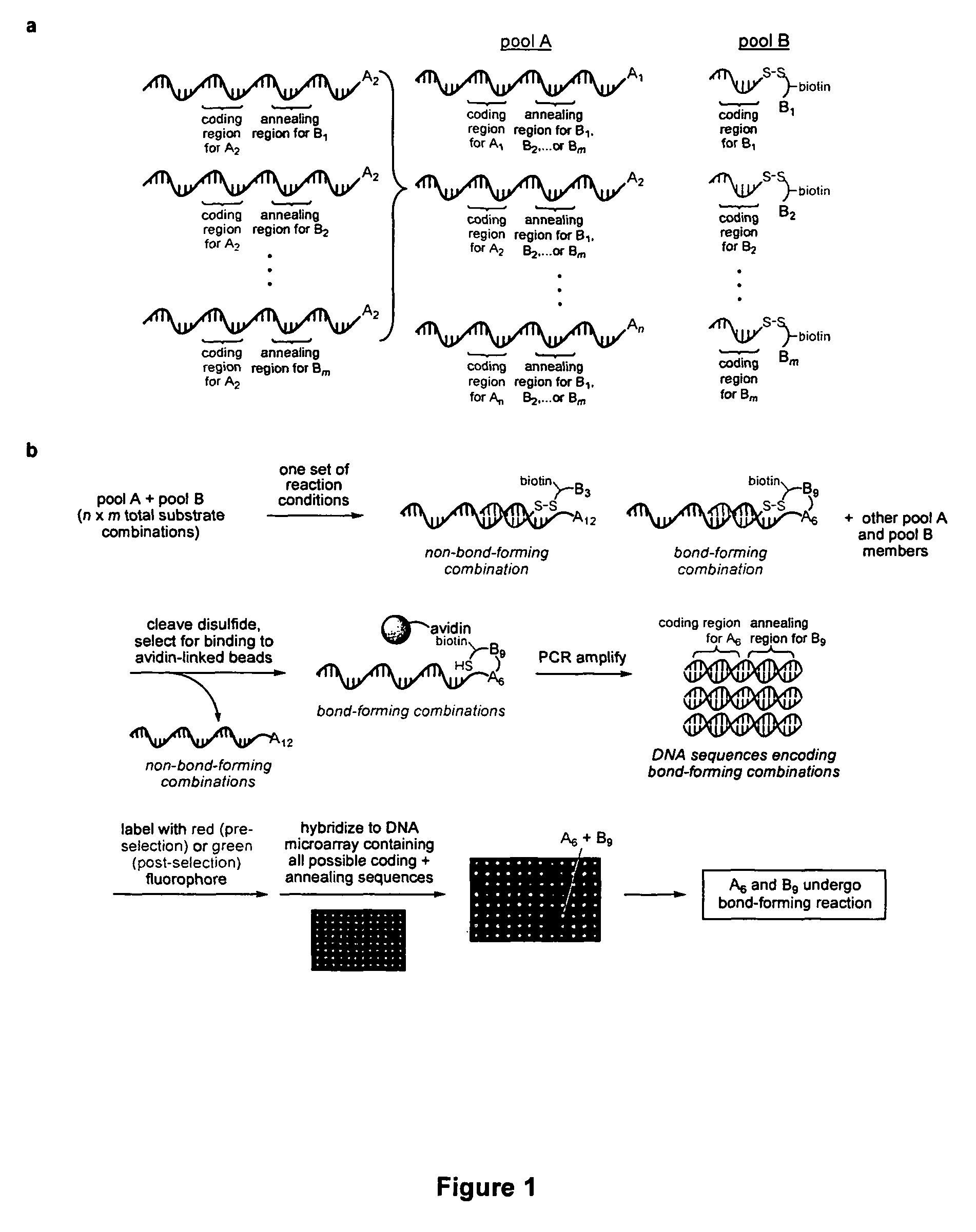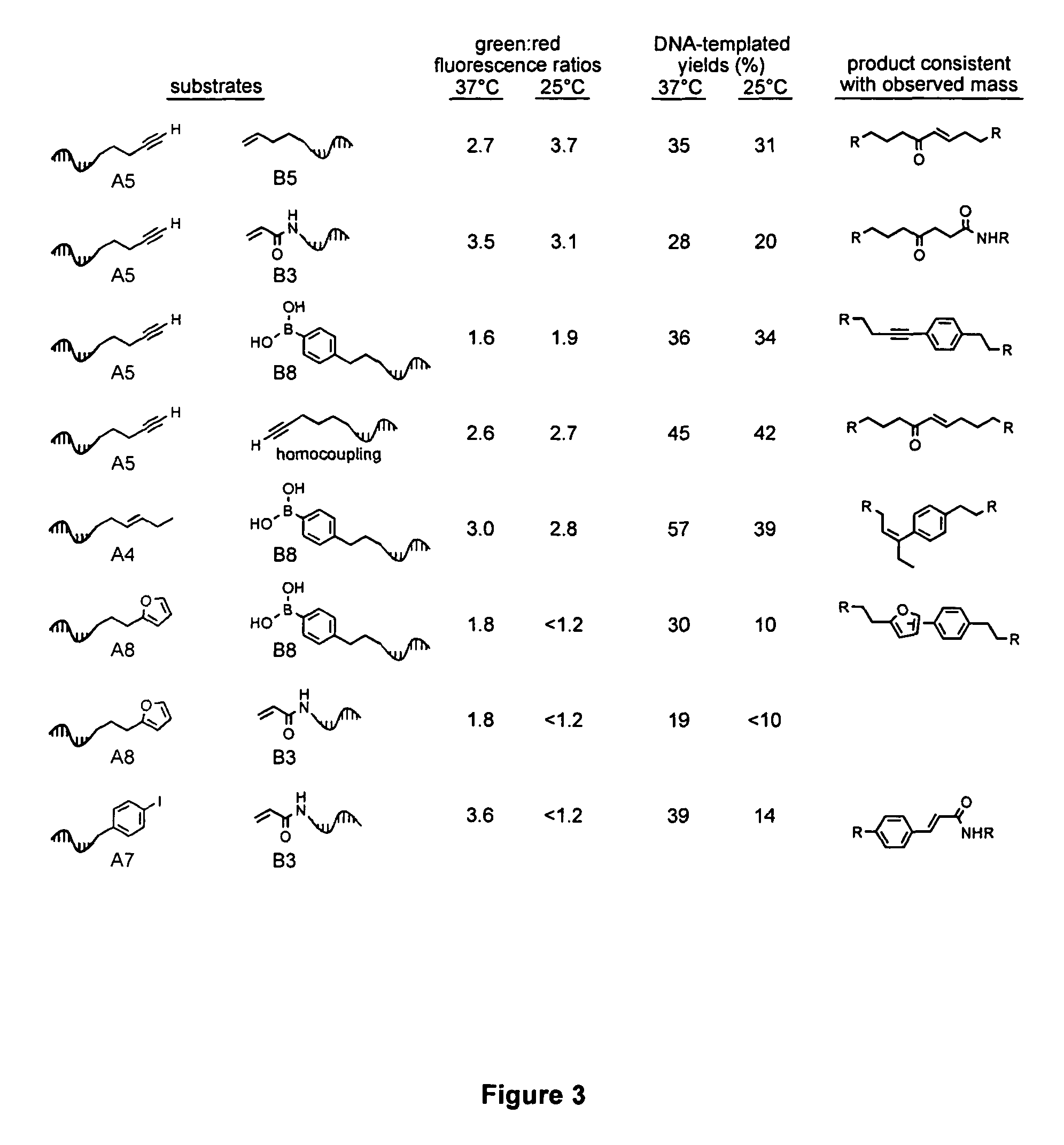Palladium-catalyzed carbon-carbon bond forming reactions
a carbon-carbon bond and catalyzed technology, applied in the field of palladium-catalyzed carbon-carbon bond forming reactions, can solve the problems of many areas of chemical reactivity unexplored, and does not lend itself to the discovery of entirely new chemical reactions, and achieve good yield
- Summary
- Abstract
- Description
- Claims
- Application Information
AI Technical Summary
Benefits of technology
Problems solved by technology
Method used
Image
Examples
example 1
Reaction Discovery Enabled by DNA-Templated Synthesis and In Vitro Selection
[0096]Recent developments in DNA-templated organic synthesis (Calderone, C. T., Puckett, J. W., Gartner, Z. J. & Liu, D. R. Directing otherwise incompatible reactions in a single solution by using DNA-templated organic synthesis. Angew. Chem. Int. Ed. 41, 4104-8 (2002); Gartner, Z. J. & Liu, D. R. The generality of DNA-templated synthesis as a basis for evolving non-natural small molecules. J. Am. Chem. Soc. 123, 6961-3 (2001); Gartner, Z. J., Kanan, M. W. & Liu, D. R. Expanding the reaction scope of DNA-templated synthesis. Angew. Chem. Int. Ed. 41, 1796-1800 (2002); Rosenbaum, D. M. & Liu, D. R. Efficient and Sequence-Specific DNA-Templated Polymerization of Peptide Nucleic Acid Aldehydes. J. Am. Chem. Soc. 125, 13924-5 (2003); each of which is incorporated herein by reference) suggest that DNA annealing can organize many substrates in a single solution into DNA sequence-programmed pairs. To this end, we p...
example 2
Palladium (II)-mediated oxidative coupling of terminal alkynes and terminal alkenes
[0211]Both intra- and intermolecular Pd(II)-catalyzed oxidative couplings of terminal alkynes and terminal alkenes have been examined. We initially discovered that intramolecular substrate 1 forms a macrocyclic trans-disubstituted enone 2 with either stoichiometric Pd(II) or as little as 5 mol % Pd(II) and a stoichiometric oxidant such as CuCl2, O2, or benzoquinone. This reaction is rather insensitive to solvent composition and proceeds in aqueous NaCl, or up to 90% THF or 90% ACN. A few specific examples or reaction conditions are shown below. The reaction proceeds optimally if the substrate is slowly added to Pd(II)+oxidant. If the substrate is not added slowly, we observe significant quantities of enyne 2′ by NMR. Enyne 2′ may be an intermediate that undergoes a Pd(II)-mediated hydration of the alkyne to form 2 under the reaction conditions. When the substrate is not added slowly, precipitation of ...
PUM
| Property | Measurement | Unit |
|---|---|---|
| temperature | aaaaa | aaaaa |
| temperature | aaaaa | aaaaa |
| temperature | aaaaa | aaaaa |
Abstract
Description
Claims
Application Information
 Login to View More
Login to View More - R&D
- Intellectual Property
- Life Sciences
- Materials
- Tech Scout
- Unparalleled Data Quality
- Higher Quality Content
- 60% Fewer Hallucinations
Browse by: Latest US Patents, China's latest patents, Technical Efficacy Thesaurus, Application Domain, Technology Topic, Popular Technical Reports.
© 2025 PatSnap. All rights reserved.Legal|Privacy policy|Modern Slavery Act Transparency Statement|Sitemap|About US| Contact US: help@patsnap.com



